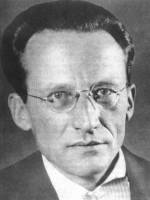Sir William Lawrence Bragg
James Bryant Conant
Roscoe Dickinson
Samuel Goudsmit
Roger Hayward
Werner Heisenberg
Walter Heitler
Arthur Lamb
Irving Langmuir
G. N. Lewis
Fritz London
Robert Millikan
Robert Mulliken
A. A. Noyes
J. Robert Oppenheimer
Wolfgang Pauli
Linus Pauling
Erwin Schrödinger
John Slater
Arnold Sommerfeld
J. Holmes Sturdivant
Richard Tolman
Max Theodore Felix von Laue
Don YostView all Key Participants
|

Portrait of Erwin Schrödinger, 1927.
More Info
Erwin Schrödinger1887-1961
Papers
Location: Central Library for Physics in Vienna (Zentralbibliothek für Physik in Wien)
Address: Boltzmanngasse 5, A-1090 Vienna
Size: 65 folders
Phone: +43-1-4277-27600 Fax: +43-1-4277-9276
Email: zbinfo@zbp.univie.ac.at Web: http://www.zbp.univie.ac.at/schrodinger/euebersicht.htm
Correspondence
Pictures and Illustrations
Manuscript Notes and Typescripts
- "Intensitäten nach der Wellenmechanik." 1926 - 1927.
- Notes on 'Die Wasserstoffähnlichen Spelstren von Standpunkt der Polarisierbarkeit
des Atomorenipfes', Schrödinger, Anm. d. Physik. 77, 43 (1925). 1926 - 1927.
- "Quantum Mechanics Averages." 1926 - 1927.
- "The Combination of Two Hydrogen Atoms." 1926 - 1927.
- "The Electrical Conductivity of Metallic Solid Solutions." August 3, 1926.
- Examination: Introduction to Wave Mechanics. 1927.
- Lecture Notes: Quantum Mechanics. 1927 - 1928.
- Translation of 'Des Adiabstenprinzip ui [?] der Quantenmechanik', M. Born, z.f. Phys.,
40, 167 (1926). 1928.
- Translation of 'Des Adiabstenprinzip ui [?] der Quantenmechanik', M. Born, z.f. Phys.,
40, 167 (1926). 1928.
- Translation of 'Zur Theorie des Kernzerfalls', M. Born, z. f. Phys., 58, 306 (1929). 1929.
- Berkeley Lectures. February - May 1929.
- Berkeley Lectures. March - April 1930.
- Berkeley Lectures. March - April 1930.
- Pasadena Lectures. October - December 1931.
- "The Normal State of the Helium Molecule Ions He2+ and He2++." 1932 - 1934.
- Berkeley Lectures. February - March 1932.
- Examinations, Lecture Notes: Introduction to Quantum Mechanics with Chemical Applications,
Ch 156a, Ch 156b, Ch156c, 1933 - 1934.
- "The Chemical Bond and the Structure of Molecules" 1935.
- "Modern Structural Chemistry." December 11, 1954.
- "The Development of the Concept of the Chemical Bond." January 17, 1983.
Quotes
"I think that it is very interesting that one can see the [psi] functions of Schrödinger’s
wave mechanics by means of the X-ray study of crystals. This work should be continued
experimentally. I believe that much information regarding the nature of the chemical
bond will result from it."
Linus Pauling. Letter to A. A. Noyes. 1926.
"One day, late in the day...I had an idea. It was the basic idea of hybrid orbitals.
I was trying to understand why the carbon atom is tetrahedral, forms bonds directed
towards the four corners of a tetrahedron. Even as early as 1924, I had made a model
of methane, in which I said the four outer electrons of the carbon are in orbits directed
towards the corners of a tetrahedron.... When quantum mechanics came along, a result
was confirmed that had been accepted earlier, that the four outer electrons in the
carbon are of two different kinds.... I thought 'the basic principles of quantum mechanics
permit us to combine these functions from the Schrödinger equation in another way.'
And I said to myself: 'Let’s suppose that I look just at the distribution in various
directions, and not worry about the difference in the radial distribution for those.'
This permitted rather simple calculations to be made in a straightforward manner.
The first result I got was that the best bonds that the carbon atom can form are directed
towards the four corners of a tetrahedron. So, in 1931, I had a simple theory of the
tetrahedral carbon atom and an explanation of a great bit of organic chemistry."
Linus Pauling. AHQP (Archive for the History of Quantum Physics), volume 6. March 27, 1964.
"For Schrödinger, the atom was an oscillating system -- like the string of a musical
instrument -- for which there exist a number of modes of oscillation (fundamentals
and overtones) which are interpreted as the atom's energy states. Schrödinger's wave
equation impressively provided -- without any additional assumptions -- the right
values for spectral lines of the hydrogen atom."
Armin Hermann. Werner Heisenberg 1901-1976, pg. 36. 1976. Audio Clips
Video Clips
|

